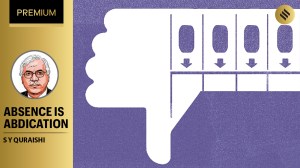Social welfare and 10% GDP growth possible, says Kinetic Group’s Arun Firodia
To spur private-sector investment, Arun Firodia suggests the Centre invest heavily in freight corridors to all ports and promote exports, among other measures.
 Arun Firodia, Chairman of Kinetic Group. (Photo: Kinetic Communications Ltd.)
Arun Firodia, Chairman of Kinetic Group. (Photo: Kinetic Communications Ltd.)In an interview with The Indian Express, Arun Firodia, Chairman of Kinetic Group, said that India’s economy needs to grow 10 per cent annually so that the country can spend more money on social welfare schemes and also become Viksit Bharat. He also called for exempting MSMEs from all labour laws and social-security obligations like the provident fund and gratuity.
Excerpts from an interview:
Q: What’s your take on the Union Budget presented last week?
Arun Firodia: The finance minister has announced many good schemes. I wish greater emphasis was given to
a) export promotion by building a dedicated freight corridor, providing subvention of cost of electricity, interest and logistics, providing credit for keeping export stock in godowns
b) employment generation by exempting micro, small and medium enterprises from labour laws
c) enabling farmer to take two or even three crops by promoting water conservation in farms
d) promoting private-sector investment by reinstating investment allowance reserve and allowing accelerated depreciation.
Q: How do you view the government’s social welfare schemes?
Arun Firodia: Social welfare schemes, variously called Modi ki guarantee, MNREGA and PURA are going to stay since the majority poor have demonstrated and will continue to demonstrate their clout, hopefully peacefully, in the elections.
Since it is high income countries that afford to spend on social welfare, we need to become a high-income country to afford such spending. For that to happen we need to grow our economy by 10 per cent consistently. That will also realise the dream of Viksit Bharat and eliminate unemployment.
Let us work out a roadmap to realize this trinity.
Q: You wish to focus on export promotion. Any particular reason?
Arun Firodia: The buying power of Indian consumers is limited. Rural consumers lack resources to buy much beyond the essentials. The urban middle class is busy meeting the high cost of housing rentals, children’s education costs and heavy medical bills of their parents. The rich buy only swanky imported stuff. Let us not despair. Export holds the key to economic growth and prosperity. With an exchange rate of almost Rs 84 to US$, export is highly profitable too.
Digital services export is our prime export and it is growing rapidly. Yet even Ireland is ahead of us in this category. We should aim to become the “office of the world”. The scope of BPO enterprises could be extended to cover government records, taxation matters, legal matters.
Our expertise in Aadhaar cards and Rupay should be taken advantage of. We should quickly train tens of thousands IT experts in artificial intelligence and encourage top companies like Nvidia to establish their research and development centres in India. It is expected that services export would reach $800 billion within the next six years from $340 billion at present and take our growth rate from 6.5 per cent to 7.5 per cent.
Q: Why does our merchandise export suffer compared to others?
Arun Firodia: ‘China + 1’ is the mantra of the day but our merchandise export lags behind our potential. The reason is simple: we rank 63rd in the ease-of-doing-business ranking, behind Kenya, Malaysia, Kazakhstan, and even Rwanda!
Single-window clearance for all formalities to set up a factory within three months should be urgently established in all states. But that is not all. Our manufacturers are uncompetitive because their cost of electricity, interest and logistics is thrice as much as that of Asian Tigers. The Government should offer subvention of these costs to industries in proportion to their exports.
Exporters also need subvention of interest costs to be able to maintain stock in the warehouse near importers’ factories. It is expected that merchandise export would add at least $20 billion to $30 billion and further enhance our growth rate to 8 per cent.
Our varied climate, fertile soil, abundant rainfall and sunlight make it possible to grow all types of fruits and flowers. We can export pomegranates, mangoes, watermelons, mushrooms, grapes at double the price of what we get in India.
Q: What is the solution?
Arun Firodia: To begin with, we should identify the products to be exported and invite foreign companies to lease 1,000 acres of land at suitable locations, produce their favourite product and export. A Japanese company may like to grow and export mushrooms and watermelons, a French company may like to grow grapes and export wines, a Dutch company may like to grow and export flowers and so on.
Our farmers will learn how to grow these crops and our entrepreneurs can learn how to market these products. Our farmers can also learn from an Israeli company how to do farming in an arid zone.
Horticulture and floriculture amount to 5 per cent of our GDP. If we additionally produce and export 10 per cent, our GDP growth rate would increase to 8.5 per cent.
Q: How can we double rural income?
Arun Firodia: It is possible to double rural income by enabling rural producers to sell directly to urban consumers.
In general, villages are located within 40 km of district towns. The use of cellphones would enable an urban customer to ask for direct delivery of milk, vegetables, eggs or even cooked food. They will use electric vehicles that have very low running costs and can be charged at night when power is available in villages.
Since the village economy amounts to 15 per cent of GDP, even 5 per cent of our villagers are able to double their income by direct selling. It would take our growth rate from 8.5 per cent to 9 per cent.
Every drop of water that comes with rainfall should be harvested by digging borewells in nullahs and by digging recharge structures at the lowest point within every arable acre of rural land. It enables multiple crops as a result of the increased water table by the Jaltara technique (https://waterconservation.artofliving.org)
Since the village economy amounts to 15 per cent of GDP, even 5 per cent of our villagers are able to double their income by double-cropping. It would take our growth rate from 9 per cent to 9.5 per cent.
Q: What’s your take on the tourism sector?
Arun Firodia: We should develop special packaged tours of the Buddhist circuit of Lumbini, Gaya, Sarnath, Rajgir, Nalanda to attract millions of Asian tourists.
Also innumerable Hindu pilgrimage centres. Sikhs, Muslims and Jains too are very religious and will come from all over the world. Similarly we can develop packaged tours for adventure lovers, nature lovers, heritage lovers and tiger lovers. With good connectivity and excellent hospitality this sector can grow by 10 per cent every year from present $240 billion to $360 taking our growth rate to 10 per cent.
Q: Your growth mantra for the economy?
Arun Firodia: In order to grow our economy by 10 per cent, we need to substantially increase the investment. Presently investment by the Central Government is spurring our growth. Now is the time the private sector should be induced to augment their investment. For that to happen, the Government should reinstate the investment allowance reserve for a period of five years. And companies should be allowed to provide accelerated depreciation.
The Central Government should continue to make heavy investments especially in building dedicated freight corridors to all ports. That would augment merchandise export substantially. And making matching contributions to states in making our cities liveable, in food preservation silos, cold storage and the gamma ray radiation facility in renewable energy generation, climate change initiatives, sustainability, interlinking of rivers to transfer water to deficit areas.
We should exempt MSMEs and rural industries from all labour laws, the PF and gratuity, etc. They should be allowed to employ contract labour and job trainees.
In Urban areas, the Government should start employment-linked incentive schemes. The companies taking advantage of these schemes should be allowed to use their CSR funds for starting a skilling centre to help employment-cum-resettlement of employees. That will help solve the unemployment problem.
In short, The Government can continue their social welfare schemes and achieve 10 per cent economic growth, year after year.












